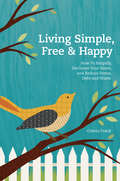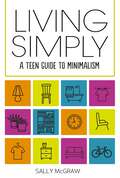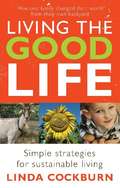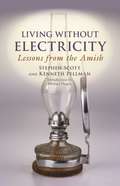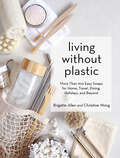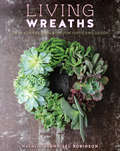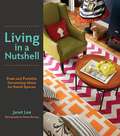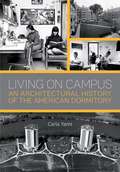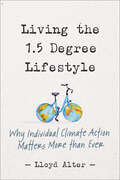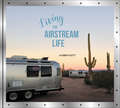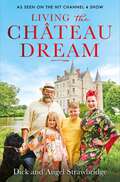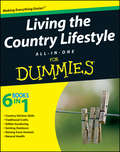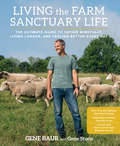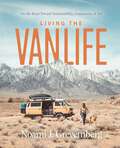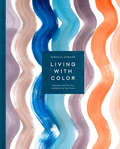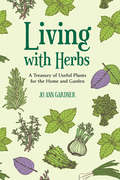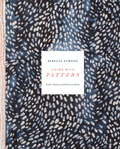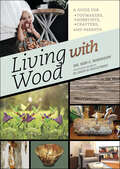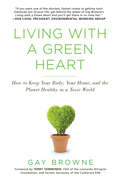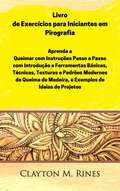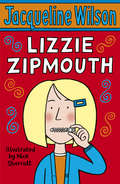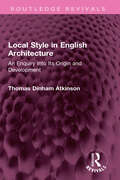- Table View
- List View
Living Simple, Free & Happy: How to Simplify, Declutter Your Home, and Reduce Stress, Debt & Waste
by Cristin FrankUpcycle Your Life Get ready to trade in headaches and hassles for life skills, exchange clutter for money, transform eyesores into beautiful focal points in your home, and say goodbye to over-consumption and hello to genuine experiences. Cristin Frank, the original Reduction Rebel, shows you the freedom and fulfillment you can have when you simplify your life. You'll learn how to use your talents, time, and space to combat stress, become more efficient, relieve money woes, open up opportunities, and provide unbelievable self-fulfillment. Inside you'll find: Simple techniques that eliminate clutter and keep it from returning A personalized plan to help you reclaim your time Practical (and profitable) ways to sell unused items in your home Tips to eliminate debt and curb consumption Step-by-step upcycling projects that transform old, unwanted furniture into beautiful, customized organizing systems Dozens of exercises that help you identify and honor your talents, values, and goals As Cristin says, "success is getting what we want." Let this book show you how to let go of what's holding you back so you can put your energy into your dreams and interests and build your success.
Living Simply: A Teen Guide to Minimalism
by Sally McGrawTwenty-first-century minimalism is an increasingly mainstream response to global environmental crises such as climate change, the garbage glut, fast fashion, and other manifestations of the harmful impact of consumerism. Originally founded in the art world in the decades after World War II, minimalism has evolved into an Earth-friendly lifestyle focusing on the three Rs (reducing, recycling, and reusing) and on simplifying individual needs to reduce one's carbon imprint, manage anxiety and depression, and prioritize human interaction over the impulse to acquire for the sake of acquisition. Hands-on activities, how-to tips, and profiles of practicing minimalists offer real-world examples for incorporating minimalism into your life.
Living The Good Life: How One Family Changed Their World from Their Own Backyard
by Linda CockburnInspiring and challenging, this chronicle of a unique household experiment takes readers inside one family's environmental test. Already mindful of the impact human activity has on the environment, the author and her family decided to take a further step towards thoughtful living by aiming for complete domestic sustainability. For six months, the Cockburns grew, bartered for, and made everything they ate; used exclusively solar power; collected rainwater for drinking, cleaning, and cooking; parked the cars and turned to bicycles; and aimed to not spend a single dollar. From just their average home on an average-sized lot, they experienced success, surprises, and challenges in their quest--all while learning about themselves as a family. Whether readers are looking for lessons on adopting some--or all--of the Cockburns' practices or are just curious about what it might take to "do it yourself" even more deeply, this story will bring them along for the ride.
Living Without Electricity: Lessons from the Amish (People's Place Book Ser. #9)
by Stephen Scott Michael Degan Kenneth PellmanIn a modern world where technology is taking over our lives, could we lead an essential, simple life without electricity? How can we get by without computers, power tools, phones, or even basics such as electric lights and appliances? The answers lie in Amish communities and other Old Order groups in the United States, Canada, and Mexico that have been living lives off the grid while still affording to be self-sufficient for countless years.Living Without Electricity examines the Amish response to technology and shows us why and how they live without inventions other people take for granted. Taking lessons from the Amish, learn how to light a room without electricity, keep warm without centralized heating, get around without a car, communicate without a phone, and others. In addition, take Amish instruction on how to cook and store food, pump water, wash clothes, and even run farms and businesses, all while off the electric grid. Reconsider the basic necessities of your life, and you might decide to orientate yourself toward a self-sufficient life without electricity.
Living Without Plastic: More Than 100 Easy Swaps for Home, Travel, Dining, Holidays, and Beyond
by Christine Wong Brigette Allen“An eye-opening guide on how to lessen one’s dependence on plastics. . . . This is a clarion, convincing wake-up call to the scope of the global plastic problem and what readers can do about it. —Publishers Weekly <P><P>Embrace a plastic-free lifestyle with more than 100 simple, stylish swaps for everything from pens and toothbrushes to disposable bottles and the 5 trillion plastic bags we use—and throw out—every year. Use a natural loofah, not a synthetic sponge Buy milk in glass bottles or make homemade nut milk Opt for a waste-free shampoo bar Skip the printed receipt and opt for an email instead Wrap gifts beautifully with cloth <P><P>Organized into five sections—At Home, Food & Drink, Health & Beauty, On the Go, and Special Occasions—Living Without Plastic is a cover-to-cover collection of doable, difference making solutions, including a 30-Day Plastic Detox Program.
Living Wreaths: 20 Beautiful Projects for Gift and Decor
by Natalie Bernhisel RobinsonA floral designer shares step-by-step instructions for crafting these gorgeous natural sculptures. Wreaths date back to ancient times, and still symbolize welcome and comfort today. They also range from the plain to the dazzlingly creative. From the simplest herb wreath to more extravagant succulent designs, the strong outlines and shapes of the living wreaths in this book have great visual impact. Natalie Bernhisel Robinson uses step-by-step instructions, an encouraging voice, and gorgeous photographs illustrating her techniques to teach you how to make not just a wreath but a modern garden in miniature that changes to become even more beautiful as the plants mature. Includes echeveria, hens and chicks, cactus, moss, strawberry, tomato, herb, lettuce, lavender, and more!
Living in a Nutshell
by Janet LeeA fireplace on wheels? A chandelier light by Xerox? A shrink-wrapped designer closet? These are just a few of the more than one hundred innovative projects in Living in a Nutshell, a DIY guide of decorating ideas that fool the eye into seeing and believing a little lair is larger and more glamorous than its four walls. Here are fresh ideas for enhancing every living area of a tiny space. All are simple, affordable, portable, and big on style. An illustrated survival tool kit as well as extensive listings of untapped, off-the-beaten-track design resources and a select buying guide round out this invaluable book.
Living on Campus: An Architectural History of the American Dormitory
by Carla YanniAn exploration of the architecture of dormitories that exposes deeply held American beliefs about education, youth, and citizenshipEvery fall on move-in day, parents tearfully bid farewell to their beloved sons and daughters at college dormitories: it is an age-old ritual. The residence hall has come to mark the threshold between childhood and adulthood, housing young people during a transformational time in their lives. Whether a Gothic stone pile, a quaint Colonial box, or a concrete slab, the dormitory is decidedly unhomelike, yet it takes center stage in the dramatic arc of many American families. This richly illustrated book examines the architecture of dormitories in the United States from the eighteenth century to 1968, asking fundamental questions: Why have American educators believed for so long that housing students is essential to educating them? And how has architecture validated that idea? Living on Campus is the first architectural history of this critical building type. Grounded in extensive archival research, Carla Yanni&’s study highlights the opinions of architects, professors, and deans, and also includes the voices of students. For centuries, academic leaders in the United States asserted that on-campus living enhanced the moral character of youth; that somewhat dubious claim nonetheless influenced the design and planning of these ubiquitous yet often overlooked campus buildings. Through nuanced architectural analysis and detailed social history, Yanni offers unexpected glimpses into the past: double-loaded corridors (which made surveillance easy but echoed with noise), staircase plans (which prevented roughhousing but offered no communal space), lavish lounges in women&’s halls (intended to civilize male visitors), specially designed upholstered benches for courting couples, mixed-gender saunas for students in the radical 1960s, and lazy rivers for the twenty-first century&’s stressed-out undergraduates. Against the backdrop of sweeping societal changes, communal living endured because it bolstered networking, if not studying. Housing policies often enabled discrimination according to class, race, and gender, despite the fact that deans envisioned the residence hall as a democratic alternative to the elitist fraternity. Yanni focuses on the dormitory as a place of exclusion as much as a site of fellowship, and considers the uncertain future of residence halls in the age of distance learning.
Living the 1.5 Degree Lifestyle: Why Individual Climate Action Matters More than Ever
by Lloyd AlterStop thinking about efficiency and start thinking about sufficiency Living the 1.5 Degree Lifestyle reveals the carbon cost of everything we do, identifying where we can make big reductions, while not sweating the small stuff.The international scientific consensus is that we have less than a decade to drastically slash our collective carbon emissions to keep global heating to 1.5 degrees and avert catastrophe. This means that many of us have to cut our individual carbon footprints by over 80% to 2.5 tonnes per person per year by 2030. But where to start?Drawing on Lloyd Alter's journey to track his daily carbon emissions and live the 1.5 degree lifestyle, coverage includes:What it looks like to live a rich and truly green lifeFrom take-out food, to bikes and cars, to your internet usage – finding the big wins, ignoring the trivial, and spotting marketing ploysThe invisible embodied carbon baked into everything we own and why electric cars aren't the answerHow to start thinking about sufficiency rather than efficiencyThe roles of individuals versus governments and corporations.Grounded in meticulous research and yet accessible to all, Living the 1.5 Degree Lifestyle is a journey toward a life of quality over quantity, and sufficiency over efficiency, as we race to save our only home from catastrophic heating.
Living the Airstream Life
by Karen FlettIllustrated with rare and exclusive images from the official company archives, an authoritative and entertaining guide to the wildly popular, beautifully designed luxury recreational vehicle that has become a cultural icon, embodying the American spirit of freedom and adventure—and the ideal in mobile living.With its distinctive silver-bullet shaped profile, the Airstream has been an integral part of the American recreational landscape for more than eighty-five years. Since the 1930s, thousands of Americans have used it as a personal canvas to paint their own unique story as they’ve traveled the road of life, and today, these stunning, nostalgia-laden vehicles are more popular than ever. In Living the Airstream Life, Karen Flett tells the unique story of the designers who have transformed the brand into a mainstay of American life and the dreamers who have found their home, and their heart, in an Airstream. Living the Airstream Life is a tour along the diverse roads aficionados have taken in chasing their Airstream dreams. Stunning color photographs featuring new and vintage versions and compelling stories capture the allure of the Airstream and offer advice and insight on the practicalities of adopting this lifestyle. With spectacular photography and compelling stories, Living the Airstream Life offers inspiration for those actively pursing the dream of life on the road—whether for permanent living or as a temporary escape from the daily grind—and everyone who wants to live vicariously through those who dare.
Living the Château Dream: As seen on the hit Channel 4 show Escape to the Château
by Dick Strawbridge Angel StrawbridgeTHE FOLLOW-UP TO THE MASSIVE SUNDAY TIMES BESTSELLER, A YEAR AT THE CHATEAU!In January 2015 Dick and Angel Strawbridge embarked on the journey of a lifetime when they swapped their cosy two-bedroom flat in East London for a derelict château in the Loire Valley.Where Sunday Times bestseller A Year at the Château told the entertaining and heart-warming beginning of the family's French adventure, Living the Château Dream is about the years of hard graft that followed as Dick and Angel leapt into action transforming Château-de-la-Motte Husson into both a thriving family home and a sustainable business.From throwing open the shutters to new suites, to exploring the walled garden, launching their wedding business and hosting guests, no stone was left unturned. With enormous tasks, like installing a lift, plus the beginnings of lifelong traditions, this much-anticipated follow-up includes many firsts for the Strawbridge family. As Dick and Angel recount stories of the next two years at the château, we start to understand the true extent of the work and skill that it has taken to make this incredible house into a much-loved home.With never-before-told stories of remarkable discoveries, amazing transformations and once-in-a-lifetime celebrations, this book is sure to delight and inspire in equal measure!
Living the Château Dream: As seen on the hit Channel 4 show Escape to the Château
by Dick Strawbridge Angel StrawbridgeIn January 2015 Dick and Angel Strawbridge embarked on the journey of a lifetime when they swapped their cosy two-bedroom flat in East London for a derelict château with 12 acres of land in the Loire valley.Where Sunday Times bestseller A Year At The Château told the entertaining and heartwarming beginning of the family's French adventure, as they found their forever home and began to restore and renovate the dilapidated castle, Living The Château Dream is about the years of hard graft that followed. Dick and Angel leapt into action transforming Château-de-la-Motte Husson into both a thriving family home and a sustainable business, and began making their dream of rural life in a fairytale castle a reality.From throwing open the shutters to new suites to exploring the walled garden, launching their wedding business and hosting guests for food lover weekends, no stone was left unturned. From the day-to-day tasks like installing a lift to the beginnings of lifelong traditions and memories such as investigating the seasonal delights of the surroundings and having a family sleepover on the moat, this much-anticipated follow-up includes many firsts for the Strawbridge family. As Dick and Angel recount stories of the renovations that took place over the next four years at the château, we start to understand the true extent of the work and skill that it has taken to make this incredible house into a much-loved home.With stories of remarkable discoveries and unexpected challenges, amazing transformations and once-in-a-lifetime celebrations, this book is sure to delight, entertain and inspire fans in equal measure.
Living the Country Lifestyle All-In-One For Dummies
by Tracy BarrLiving the Country Lifestyle All-in-One For Dummies features six books in one, including:Country Cooking (cast-iron cooking, canning, pickling, and outdoor cooking, among other topics)Traditional Crafts (sheering animals and producing wool, knitting, hand sewing, patchwork and quilting, candle making)Kitchen Gardening (growing and caring for vegetables, herbs, and fruit)Outdoor Skills (camp skills, fishing, navigation, outdoor family fun)Raising Farm Animals (buying, housing, and raising animals, beekeeping)Natural Health (herbal remedies, an encyclopedia of herbs, and healing foods)
Living the Farm Sanctuary Life: The Ultimate Guide to Eating Mindfully, Living Longer, and Feeling Better Every Day
by Gene Stone Gene Baur<p>Winner of a Books for a Better Life Award!Gene Baur, the cofounder and president of Farm Sanctuary, the nation's leading farm animal protection organization, knows that the key to happiness lies in aligning your beliefs with your actions. <p>In this definitive vegan and animal-friendly lifestyle guide, he and Gene Stone, author of Forks Over Knives, explore the deeply transformative experience of visiting the sanctuary and its profound effects on people's lives. <p>The book covers the basic tenets of Farm Sanctuary life—such as eating in harmony with your values, connecting with nature wherever you are, and reducing stress—and offers readers simple ways to incorporate these principles into their lives. <p>Living the Farm Sanctuary Life also teaches readers how to cook and eat the Farm Sanctuary way, with 100 extraordinarily delicious recipes selected by some of the organization's greatest fans—chefs and celebrities such as Chef AJ, Chloe Coscarelli, Emily Deschanel, and Moby. <p>Coupled with heartwarming stories of the animals that Farm Sanctuary has saved over the years, as well as advice and ideas from some of the organization's biggest supporters, Living the Farm Sanctuary Life is an inspiring, practical book for readers looking to improve their whole lives and the lives of those around them—both two- and four-legged.
Living the RV Life: Your Ultimate Guide to Life on the Road
by Marc Bennett Julie BennettWhether you’re downsizing or thrill-seeking—or anything in between—find out if the RV lifestyle is right for you, and learn how to transition from a life of traditional home-ownership to one on the road. Do you love traveling? Meeting new people and seeing new places? Are you craving a life that feels meaningful and new? The RV lifestyle could be the answer. Both aspirational and practical, Living the RV Life is your ultimate guide to living life on the road—for people of all ages looking to downsize, travel, or work on the go. Learn if life in a motor home is right for you, with insightful details on the experiences of full-time RV-ers, tips for how to choose an RV (how big? new or used?), whether to sell your home (and if not, what to do with it), model costs, sample routes and destinations, basic vehicle maintenance, legal and government considerations—and much more! Written in a light and an easy-to-understand style, Living the RV Life is your bible to living a mobile life.
Living the Vanlife: On the Road Toward Sustainability, Community, and Joy
by Noami GrevembergDiscover what it&’s really like to live and work full-time on the road in a camper van from eco-vanlifer and founder of the Diversify Vanlife movement, Noami Grevemberg.Feeling dissatisfied with her office job and her &“stationary home,&” in 2016 Noami Grevemberg took a bold step. She quit her job, sold her belongings, and set out in her 1985 VW Vanagon to pursue a life of simplicity and travel with her husband and German Shepherd by her side. In her years living fulltime on the road, Noami has become an expert in the many aspects of vanlife. In her book Living the Vanlife, she digs into all aspects of the lifestyle, from getting over the uncomfortable feeling of uncertainty, to creating a sustainable, thriving life of adventure and a captivating path of choosing whatever it is you truly want for yourself. Through personal stories and actionable advice, Noami candidly and compassionately demonstrates for readers that challenging the "status quo&” means taking bold steps, venturing out of your comfort zone, taking risks, and living intentionally. As a Trinidadian immigrant, Noami also takes a practical look at life on the road as a BIPOC navigating many intersections and speaks to topics like converting a van to fit your specific needs, budgeting for vanlife, finding employment, staying safe, and building a supportive community on the road. Featuring evocative full-color photographs of Noami&’s journey, Living the Vanlife is an inclusive and celebratory look at an increasingly popular way of life.
Living with Color: Inspiration and How-Tos to Brighten Up Your Home
by Rebecca AtwoodDiscover inspiration from the most colorful homes in America with this vibrant lookbook and style manual that brings the magic of color into your home—from the author of Living with Pattern Personalizing your color palette may be one of the most important decisions you make in your home. The right combination of hues can set the mood and transform any room from ordinary to magical. Textile designer Rebecca Atwood invites you to take a color journey in this stunning yet practical guide. In Living with Color, you’ll tour beautifully designed homes to see some of the most interesting uses of the rainbow and to gather inspiration for your own spaces. You’ll train your eye to notice how color lives all around you, from the pink light bouncing off a building you see every day to the exact blue of the ocean on your last getaway. You can even learn how to express yourself through your own custom palette with Rebecca’s accessible, illustrated overview of color theory. As you embark on your color hunt and begin to trust your own instincts, Living with Color will embolden you to breathe life into every part of your home.
Living with Herbs: A Treasury of Useful Plants for the Home and Garden (Second Edition)
by Jo Ann GardnerWith vivid stories and an infectious delight in the garden, Jo Ann Gardner shares her wisdom and useful tips on planting, growing, and harvesting more than 90 different kinds of herbs. Every gardener will benefit from the author's intimate knowledge of herbs and their histories, growing needs, and uses in the kitchen and home. The wisdom she shares--with vivid stories, a self-deprecating wit, and an infectious delight in the garden--will be useful to herb growers living anywhere in the United States or Canada. Included in this practical guide is instruction on: * Planting, caring for, and propagating herbs indoors, outdoors, and in containers * Harvesting, drying, and preserving herbs, flowers, and seeds * Two dozen ways to use herbs in the home, from aromatherapy and infusions to vinegars and wreaths * Landscaping with herbs, with plans for a harvest bed, rose garden, and other themed gardens * The growing needs and unique uses of more than 90 herbs, along with favorite recipes "Readers from all regions will benefit from these simple strategies for dealing with common problems." --Booklist
Living with Pattern: Color, Texture, and Print at Home
by Rebecca AtwoodIf you focus on pattern, from texture and color to furniture and textiles, everything else will fall into place. Pattern is the strongest element in any room. In Living with Pattern, Rebecca Atwood demystifies how to use that element, a design concept that often confounds and confuses, demonstrating how to seamlessly mix and layer prints throughout a house. She covers pattern usage you probably already have, such as on your duvet cover or in the living room rug, and she also reveals the unexpected places you might not have thought to add it: bathroom tiles, an arrangement of book spines in a reading nook, or windowpane gridding in your entryway. In this stunning book, beautiful photography showcases distinct uses of pattern in homes all over the country to inspire you to realize that an injection of pattern can enliven any space, helping to make it uniquely yours.
Living with Wood: A Guide for Toymakers, Hobbyists, Crafters, and Parents
by Dr. Seri C. RobinsonA comprehensive guide for wood workers of all ages that covers the science behind wood, its many uses, and optimal care. For anyone who has ever used, owned, or been curious about wood of any kind, this guide offers a fantastic summary of the science behind the material&’s anatomy, chemistry, and general upkeep. With the practical and accessible information presented here, you&’ll never have difficulty deciding what wood to work with or how to clean your boarded floors again. Living with Wood covers a broad range of topics, including best uses of wood in the home, finishing and coloring, woodworking machines, and unsafe woods. Whether you&’re building furniture, getting crafting, or caring for wooden antiques, this is your ideal guide to the most versatile, reliable, and beautiful material ever known.
Living with a Green Heart: How to Keep Your Body, Your Home, and the Planet Healthy in a Toxic World
by Gay Browne&“If you&’re inspired to explore the ways in which you can treat the planet and your body a little better, this little book will give you a comprehensive way to get started.&”—Forbes In an increasingly toxic world, the paths to environmental health and personal well-being run parallel. The journey begins with a few small steps. Is the damage we&’re doing to our planet literally leaving you sick, sore, and gasping for air? Want to take back our inalienable rights to clean air, clean water, and healthy food? In this quietly revolutionary book, environmental pioneer and founder of Greenopia, Gay Browne, shares a roadmap for making incremental changes that will not only transform your life, but heal the world we share. From the home to the office, from the foods we eat to the clothes we wear, here are actions you can take today that will improve your Personal Environmental Health, and help you stop feeling overwhelmed, reduce illness, improve sleep, mood, and focus, and start making a difference, including: *Make conscious choices when shopping, and support companies with good environmental stewardship and healthy products. *Test your water for harmful chemicals, install an affordable water filtration system, and reduce your water use by utilizing water more efficiently. *Work with your doctor to create a personal plan for detoxing your body. *Use only non-toxic and organic household products, and choose organic, eco-friendly fabrics made by sustainable and fair trade certified companies. *Choose the method of transportation that makes the lightest carbon footprint. With these and many other actions, Gay Browne&’s work has taught her that even the smallest change for the better, faithfully practiced, can have an immense positive impact on our minds, bodies, and spirits—not to mention the planet.
Livro de Exercícios para Iniciantes em Pirografia: Aprenda a Queimar com Instruções Passo a Passo, Introdução às Ferramentas Básicas, Técnicas
by Clayton M. RinesA arte da pirografia, também conhecida como pur graphos (escrita com fogo), é tão antiga quanto a humanidade, e essa forma de arte dá uma satisfação incomensurável aos artistas, dando poder à imaginação. Este livro abre uma nova visão para você, revelando tudo o que você precisa para começar sua jornada com esta arte atemporal. No Livro de Exercícios para Iniciantes em Pirografia, Clayton M. Rines mostra os conceitos básicos de escrever com fogo, tipos de pontas, canetas, técnicas de sombreamento e outros métodos menos conhecidos que ajudam a desenvolver seu ofício. Você aprenderá os detalhes de comprar sua primeira máquina de pirografia, tipos de madeiras para queimar, dicas de segurança, manutenção da sala de trabalho e outras dicas essenciais para projetos bem-sucedidos de queima de madeira. Este livro oferece alguns projetos fáceis de realizar, como forma de acostumar-se à arte da queima de madeira, desde a fabricação de relógios de parede, porta-chaves até a criação de porta-copos e pulseiras com imagens. Você aprenderá; Projetos fáceis para todos. Aprenda a escrever, sombrear e aplicar contornos A importância das configurações de temperatura Saber que tipo de ponta de queima usar Dicas importantes de segurança Conhecer técnicas de texturização e acabamento Queime esses ótimos presentes para seus entes queridos E muito mais! Com O Livro de Exercícios para Iniciantes em Pirografia, você está no caminho de se tornar um profissional em esculturas em madeira, placas de madeira, utensílios domésticos e muito mais. Pegue o livro hoje e comece sua jornada de pirografia.
Lizzie Zipmouth
by Jacqueline WilsonLizzie refuses to speak. She doesn't want to talk to Rory or Jake, her new stepbrothers. Or to Sam, their dad. Or even to her mum. She's completely fed up with having to join a new family, and nothing can convince her to speak to them. Not football, not pizza, not a new bedroom. That is, until she meets Great-Gran - a member of the new family who is even more stubborn than she is . . .
Lo que comemos: Antes y ahora (¡Arriba la Lectura!, Level Q #35)
by Debbie CroftEn el pasado, la gente debía producir y preparar casi todo lo que comía. Solo podía comprar productos que se encontraban localmente. Hoy día, los avances en el transporte y la tecnología nos permiten disfrutar alimentos de todo el mundo. NIMAC-sourced textbook
Local Style in English Architecture: An Enquiry Into Its Origin and Development (Routledge Revivals)
by Thomas AtkinsonOriginally published in 1947, this book examines the regional styles of architecture which developed inside England itself, particularly during the later medieval period. It discusses the causes and locations of these regional variations. In explaining the cause for the geographical variations in stye, the author investigates the various factors responsible for bringing them about, such as geology, race, religion, foreign influence, transport and fashion. As churches have survived the passage of time better than many secular buildings, the emphasis is on church architecture (although not exclusively). The book contains over 120 photographs and the book is an original and important inquiry into the origin and development of local styles in English architecture.
